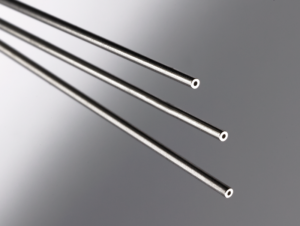Why Does Uniform Density in CuW Electrodes Matter?
Last week we talked about some of the reasons for choosing pure tungsten or molybdenum as a material for spot welding electrodes. With these pure materials, infiltration — the blending of metals throughout an electrode so that the ratio in every quadrant is uniform — is a non-issue. But what about when using an alloy such as copper tungsten, one of the most common metal blends utilized in electrodes?
An alloy of copper tungsten (CuW) combines high temperature strength and high electrical conductivity, making it a good option when spot welding high conductivity metals such as copper wire or foil. Available in various composition ratios to meet different needs, CuW is produced using powder blending and then infiltration and sintering in batches (versus being a continuous drawn product). The infiltration — the uniform dispersion of the two metals in every cubic centimeter of the electrode — is one of the critical requirements of any good electrode “recipe.”
A Look Inside CuW Electrode Infiltration
“Perfect” is always a great thing when it can be achieved, and with CuW alloy products, perfect infiltration — with the density of copper and tungsten correlating to the ratio of copper and tungsten in the particular blend — is the goal. If the ratio (percentage) of copper in the blend increases, the total density of the alloy goes down; if the tungsten ratio increases, total density goes up.
The intriguing thing is that people think about the density of a metal when they are choosing materials, but they don’t really think about the density of a blend of metals. The density is simple enough to calculate, but what is it?
In the case of CuW electrodes, the correlation between density and infiltration should be perfect — that is, r = 1. This is because of the blending of the powders and because the two constituent metals algebraically add up to a particular density based on their own densities and the percentage of each metal that is infiltrated. That means if you cut a CuW electrode into cross-sectional slices along the x, y, and z axis, each of the resulting “mini electrodes” should have the identical density.
For a product that is 20Cu-80W — that is, a blend of 20% copper and 80% tungsten by mass — the density of any portion of that product made at that ratio should be 15.6g/cm3. Appropriately, with more copper added — such as in CuW products made at the ratio of 30Cu-70W — the density drops, in this case to 14.2g/cm3. At the limits of typical consumption for CuW electrodes, a ratio of 40Cu-60W, the density drops to 13.16g/cm3. That’s a long way from the theoretical density of pure tungsten, at 19.3g/cm3, and a crucial consideration when selecting an alloy and its blend or when choosing between an alloy and a pure metal for your electrode material(s).
Every “Bite” of CuW Electrode Should Be the Same!
What’s the bottom line in infiltration and the density of copper tungsten? If you are buying a CuW electrode, what you really care about is getting the recipe you want — i.e., the ratio of copper and tungsten that is appropriate for the materials you will be welding — and a density that is uniform throughout the electrode. You are going to use 100% of the electrode, so you want every geometric section of it to have a consistent density through truly uniform infiltration.
Think of an electrode as a loaf of bread, where you expect every bit to taste the same. If you took a bite from one slice and found it was too salty, you’d think the ingredients probably hadn’t been blended together correctly. To get a uniformly tasty loaf, it is imperative that all the ingredients be uniformly dispersed. Muffin tops and brownie corners can be sought-after desserts, but their analogs in the electrode world are unacceptable!
The uniform dispersion within an electrode can be empirically tested by slicing the electrode and weighing the sample(s) to make sure every cubic centimeter weighs X grams (depending on the copper and tungsten ratio) no matter what part of the electrode you “tasted” (sampled). With copper and tungsten uniformly distributed in every bit (or bite!), the electrode’s 100% uniform density (and therefore, its hardness) does not change even if the size of the electrode changes. That means, for instance, a CuW electrode with a size of 10 x 50 mm for 30Cu-70W has the same density throughout as an electrode with the size of 20 x 100 mm for 30Cu-70W — namely, 14.2g/cm3.
Understanding the properties of different electrode materials — including the infiltration, density, and other characteristics of alloys such as CuW — is critical to welding success. If you are currently in the process of choosing an electrode material for your resistance welding production needs, you can learn more about the range of options and how some materials and alloys have been engineered to address common challenges. Simply download our free technical report.





